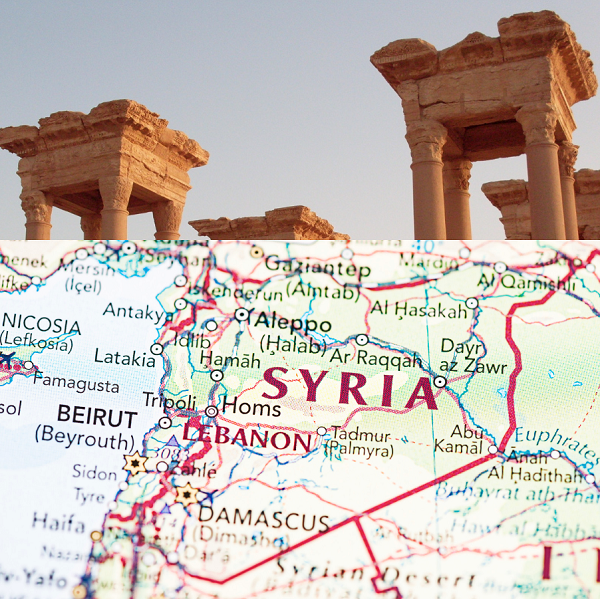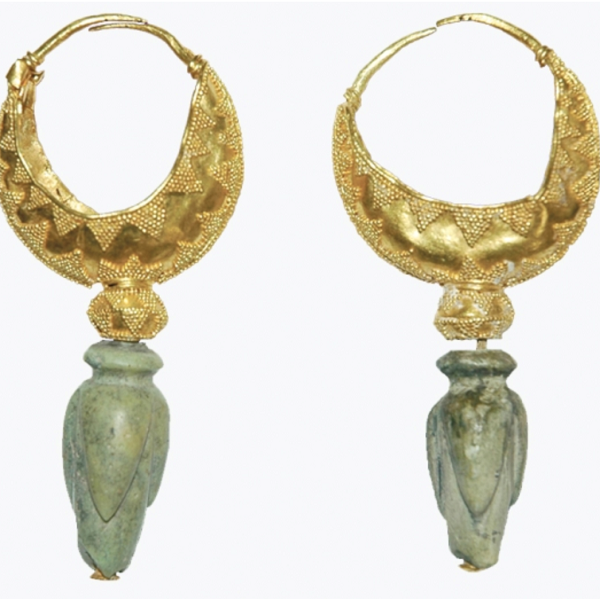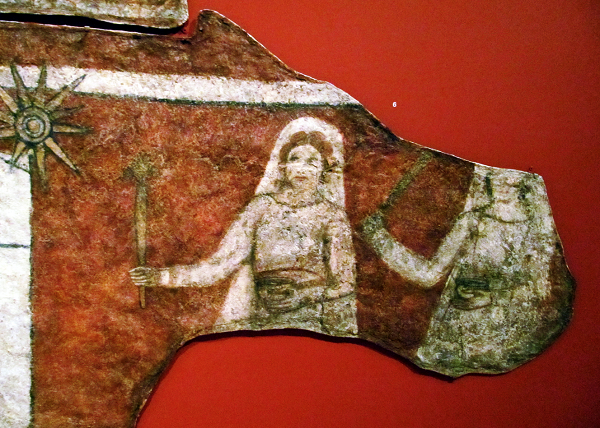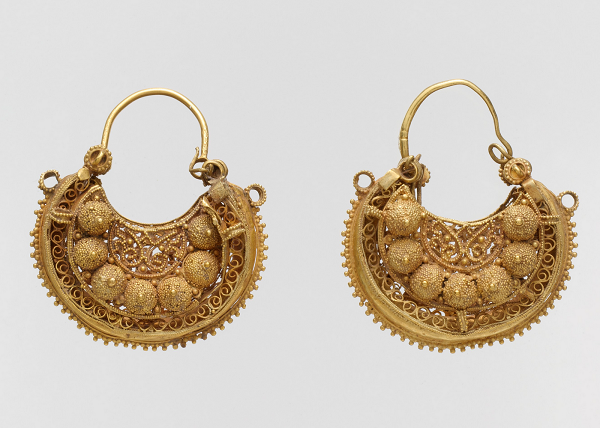In this series on jewellery, we focus on the jewellery traditions of various countries in North Africa and South-West Asia. These jewellery traditions go further back in history than the geographical borders we know today, and of course, one country may be home to several cultural traditions. Both the historical context and the cultural heritage of a variety of peoples are visible in the jewellery worn, and we hope to introduce this wider scope of adornment and dress to you. In this post, we will look at the long history of jewellery in Syria.
From caves to cities
Like in many other regions, shell beads are among the oldest forms of personal adornment in Syria. In southwestern Syria, shell beads from three archaeological sites in the foothills of the Anti-Lebanon mountain range tell us more about the importance of personal adornment at the end of the Paleolithic, some 11,000 years ago. A rock shelter at Baaz and two caves at Kozah and Ain Dabbour yielded large quantities of shell beads. These were not simply made of leftover shells after food production: analysis has shown the majority of the shells came from the Mediterranean, some 90 kilometres and two mountain ranges away!
On the banks of the Euphrates
Syria is home to some of the earliest farming communities on the banks of the river al-Furat or Euphrates. Here, settlements developed into true city-states, and by 3,500 BCE current Tell Mardikh was the seat of one of these internationally orientated kingdoms: Ebla. The kingdom traded with Cyprus, Egypt, Afghanistan, and Sumer in current-day Iraq, which is visible from the archives excavated in the city. What we also learn from the archives is the value of precious commodities such as personal adornment. Daggers, their belts, and the connecting suspension hooks seem to have been worn as a status symbol and as a carrier of identity, a practice reminiscent of the Omani and Yemeni jambiya or khanjar. Ornamental discs of silver or gold, inlaid with precious stones, were as common as bracelets, which are described as having eagle-headed terminals. What is even more fascinating is the glimpse these archives offer of a redistribution economy: jewellery is regularly melted down in exchange for other pieces. One example mentions the melting of three silver bracelets to obtain three decorative discs in low-grade gold.
Beads and trade
The royal tombs of Ebla contained gold jewellery, which was also found in the city of Ugarit in modern-day Ras Shamra. Here, goldsmiths employed filigree and granulation, as can be seen on the pair of crescent earrings shown above: a type that is still current in Syria today. In northern Syria, burials such as those found at Tell Sabi Abyad show a wide variety of jewellery: bracelets and anklets in bronze, gold, or even iron, hairpins and combs, necklaces, pendants and beads of stone, glass, faience, shell and gold. The length and width of the trade networks are demonstrated by the royal tomb at Qatna, current-day Tell Mishrife, where amber beads were identified as coming from the Baltic area. Interestingly, this tomb also contained various beads and pendants of a blue-greenish material set in gold: instead of turquoise, this is variscite, which was valued for its close resemblance to turquoise.
Dura Europos: a Roman world
In the utmost east of Syria, on the banks of the Euphrates, a city was built by the Seleucids around 300 BCE. It was conquered by the Romans in the 2nd century CE and finally destroyed by the Sassanids in the 3rd century. Called Dura Europos, this was a cosmopolitan city with temples for Graeco-Roman, Mesopotamian, and Persian gods as well as a church and a synagogue. Throughout the city, jewellery was found during excavations: lost pieces or treasures stashed away in hoards. Besides these actual pieces, the city also has numerous wall paintings showing how jewellery and dress were worn. Here, we find Roman fibulae or clothing pins indicating a strong military presence, and key-shaped rings. These were used as actual keys and are therefore very telling items: they signal the wearer owned valuable items. Silver rings with intaglios in semiprecious stones or glass show the variety of the Graeco-Roman pantheon, and bracelets with terminals in the shape of snake-heads are reminiscent of bracelets as they are still worn today.
Palmyra: showing the splendour
In the Roman city of Palmyra, elite ladies had themselves portrayed on funerary busts. These show a mixture of Roman, Persian, and Indian jewellery styles and clothing and served to show the considerable wealth of the inhabitants of the city. These busts were originally painted in bright colours, which gives us an idea of the splendour worn. They also form an interesting way of expressing identity. While in other parts of the Roman Empire women would not be shown wearing large quantities of jewellery to underscore their feminine virtues, in Palmyra the opposite was true: the more jewellery, the more honourable the lady wearing it. Here, we see how local forms of expression are used to convey similar concepts.
Medieval gold working
During the Middle Ages, Raqqa was an important centre for goldsmithing. Many jewellery pieces from the Fatimid dynasty (909-1171) have been created either in Egypt or Syria: the difference is indistinguishable. The jewellery of this period is exceptionally finely made, using wire filigree and granulation. Not much of it survived, as it was mostly melted down in later periods. The openwork filigree of the Fatimids continued to be produced under the Ottomans, albeit less delicate and in completely different shapes, and so continued into the traditional jewellery of our time.
Silver jewellery from Syria
Up until the 1960s, silver jewellery was produced and worn all over Syria by both urban and rural, sedentary and nomadic groups. Ottoman influences are visible in the elaborate, almond-shaped belt buckles and the neck chokers known as kirdan. Jewellery in the south of Syria is similar to that of Palestine and Jordan, while the jewellery of Syrian Kurdistan transcends borders into Iraqi Kurdistan. In this border area between Syria and Iraq rigid neck rings known as torques are also worn, from which long chains with talismanic pendants dangle. Damascus, Aleppo, and Deir ez-Zor were famous for their silversmithing, producing among many others the chainwork that is quite particular to Syria and its immediate surroundings, often called ‘Jerusalem chain’. This consists of quadruple loops, protruding like petals from a silver central disc. The many years of the devastating war in Syria have not only destroyed the age-old suqs but also severely impacted older heritage. Museums have been looted and are slowly beginning to be rebuilt where possible. Jewellery forms part of the millennia-old heritage of a country where civilization began: keeping this heritage alive has never been more important and urgent than it is now.
This post is based on:
- Abe, Y. et al. 2019. Use of variscite as a gemstone in the Late Bronze Age Royal Tomb at Qatna, Syria, in: Journal of Archaeological Science: Reports 27, 1-6
- Düring, B., E. Visser & P. Akkermans 2015. Skeletons in the fortress: the Late Bronze Age burials of Tell Sabi Abyad, Syria, in: Levant 47:1, 30-50
- Fortin, M. (ed) 1999. Syria. Land of Civilizations. Les Éditions de l’Homme
- Kaizer, T. (ed) 2016. Religion, Society and Culture at Dura-Europos. Cambridge University Press.
- Kalter, J. 1992. The Arts and Crafts of Syria, Edition Hansjörg Mayer, Stuttgart/London
- Kandel, A.W. et al 2017. Epipaleolithic shell beads from Damascus Province, Syria, in: Quaternary International 464, 126-140
- Klaver, S. 2019. Women in Roman Syria. The cases of Dura-Europos, Palmyra and Seleucia on the Euphrates. PhD-thesis, University of Amsterdam
- Maiocchi, M. 2010. Decorative parts and precious artefacts at Ebla, in: Journal of Cuneiform Studies 62, 1-24
- Mukherjee, A. et al. 2008. The Qatna lion: scientific confirmation of Baltic amber in Late Bronze Age Syria, in: Antiquity 82, pp. 49-59
- Prévalet, R. 2009. Preliminary observation on three Late Bronze Age gold items from Ras Shamra (Ugarit), in: ArcheoSciences 33 [link: https://journals.openedition.org/archeosciences/2111]






